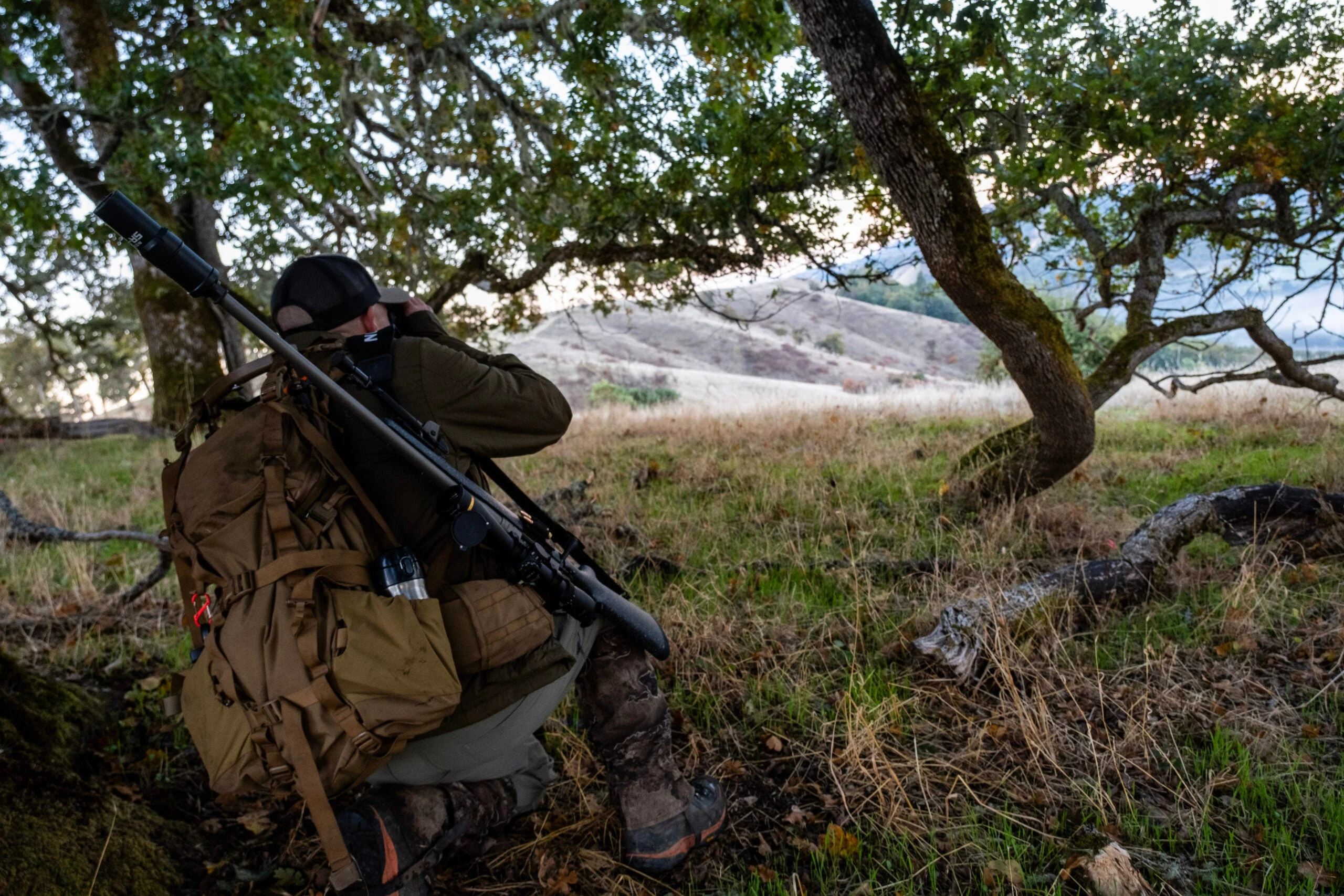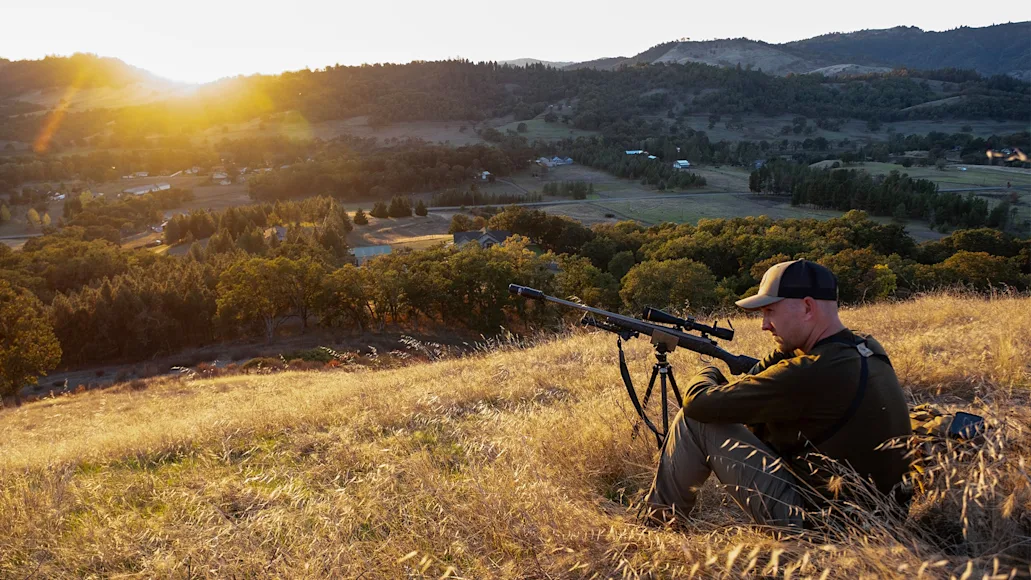We may earn revenue from the products available on this page and participate in affiliate programs. Learn more ›
I probably should’ve shot the first buck I saw. My buddy Justin Moore and I were hiking down a switchback trail on a western Oregon hillside, through prime blacktail country, but with our attention focused on the little whitetails skittering in the valley below us. A fence-line thicket and 100-yard-wide buffer of oaks separated the hillside we were on from a small housing subdivision. There were miles of wild country all around, but in classic whitetail fashion, most of the deer we saw seemed to prefer life on the fringes of back yards, where there were good gardens to pilfer and acorns fattened on fertilizer.
I first saw the 8-point in question as he strolled across a lawn, crossed behind an above-ground pool, and then meandered through the oaks. He jumped a low wire in the fence, lip-curled at a nearby doe, and then stopped to pluck blackberries from a withering vine.
Moore, a native Oregonian, whispered that it was a pretty good buck, as Columbian whitetails go. I ranged the deer at 218 yards, was seated with my rifle on shooting sticks, and the buck was standing at a safe angle to shoot, relative to the houses. There was no good reason to pass the shot, really, expect that it was only an hour into the first morning and I wanted to keep hunting. We watched the buck feed on blackberries for 45 minutes and then bed at the base of the bush. It wasn’t until quite a bit later that I started questioning the decision.
Little Deer, Big Trophy
The tiny Columbian whitetail is the westernmost whitetail subspecies in the United States, native only to a few niche habitats in Oregon and Washington. Hunting opportunities for them are exceedingly limited. They were formerly listed as an Endangered Species, but then delisted after populations recovered. Most of the modern populations are still under federal protection, but limited tags have been available since 2005 to hunt the Roseburg population along the Umpqua River, about 75 miles south of Eugene, Oregon. That’s where we were. Even here, tags for the few controlled public-land hunts held in the area can take years to draw, but a handful of outfitters do secure limited private-land-only tags. We were hunting with Jody Smith, a well-known area outfitter who guides year-around for big game, spring turkeys, and the usual fish of the Northwest, from smallmouth bass to salmon to sturgeon.

As coveted as a Columbian whitetail tag is, and as rare as I knew the deer to be, I found that these whitetail acted very much like the ones I’m used to hunting back home in Kentucky. And there were plenty of them, at least around the fencerows and oak hammocks bordering that subdivision. We saw does, fawns, and young bucks on every hunt of our week-long trip.
Smith shared some trail-camera photos with us ahead of time and cautioned us to not expect to see a Midwestern- or even Southeastern-caliber whitetail on this hunt. A big Columbian buck might weigh 120 pounds on the hoof. While most big-game-records organizations don’t have a specific Columbian whitetail category, Safari Club International does. The current SCI typical record scored 138 3/8, and the nontypical measured 144 1/8. Bucks eligible for entry into the SCI record books must score 70 inches and 80 inches, for the typical and nontypical categories, respectively.
There were some good potential tree-stand and ground-blind locations near the fencerow, but we employed western glassing and stalking tactics on these whitetails. It was perfect country for it, too. Smith drove Moore, Petersen’s Hunting editor David Draper, and I to the spine of a ridge just before daybreak, and from there we glassed and hunted our way down the hillside.
Later that first morning, looking over photos Moore had taken with a telephoto lens of the buck I passed, Smith agreed that it was probably a shooter. So Moore and I snuck back over the ridge early that afternoon and took a seat 150 yards above the blackberry bush, where we’d seen the buck bed earlier. I assumed the deer would stand and provide an easy shot sometime before dark. Instead, we never saw him again.
Close Encounter
We were socked in with fog the next morning, making for a slow sit, so we took a drive around the property at midday. The place looked like classic Pacific Coast wine country (or at least, what I expect wine country should look like; my experience with wine is limited to the stuff that’s sold in boxes). Golden hillsides rolled into oak hammocks full of mature trees and virtually no understory. As we rounded a turn on the low side of one of the hammocks, a nice buck stood from his bed and trotted into the timber, half-heartedly waving his white flag, as if he were more annoyed than alarmed.
“There’s a group of five bucks that have been bedding in there since September,” Smith said. “A little sneak through there might not be a bad plan.”
We made a wide circle back to the top of the ridge and worked ourselves into a good headwind. Draper dropped below a parallel hillside and snuck his way toward where we’d jumped the buck, figuring he might get a shot at anything I kicked out of the oaks. Moore and I stepped into the head of the oak hammock and began still-hunting our way through it, glassing more than walking. We didn’t make it far before I spotted a buck 60 yards ahead, staring back at us. He flagged and trotted out of sight, and I saw more deer trotting through the timber with him. I knew our wind was good and the deer hadn’t seemed too spooked and so I thought, as bedded whitetails sometimes do at home, these might circle back through the area, given a little time. We set our packs on the ground and stretched against them to wait.
It didn’t take long. Within 10 minutes, Moore spotted a deer slipping through the trees below us. The bucks we’d jumped were just 70 yards away and walking toward us, alert, but not enough to ignore the acorns on the ground or sparring with one another.
I zoomed my scope to 10x and settled the crosshair on the biggest buck’s shoulder, but then hesitated; I hadn’t taken a close look at him. I waited for him to turn his head and counted 8 tines, but thin ones. I flicked the safety off, looked at his shoulder again, touched the trigger—and then stopped myself. I watched him walk away through the scope. The truth was, he was a much smaller buck than the one I’d passed the previous morning.
Double Buck
Early afternoon found us back on the hillside overlooking the fencerow. I was glassing near the fence gap the buck had hopped through the first morning, and Draper was just over the hill, maybe 75 yards above me, glassing a different slope. Moore was standing between us, picking apart blackberry bushes with his spotting scope.

I looked up from my binoculars to see him motioning at me. He had a bachelor group of bucks in his spotter, including two nice 8-pointers. The best one was wide and pretty, but there was a tall, heavy buck in the mix, too. The deer were browsing on a flat 300 yards away, just below Draper. I could see him glassing the deer on the ridge above me. He motioned toward them, and I replied with a thumbs-up.
As the bucks were on his side of the ridge, I didn’t plan to shoot until after he shot first. But our rifles were suppressed, and we were far enough away, that I figured I’d get a decent opportunity if he made good on his first shot. I settled onto the hillside and began building my nest, with my pack braced against the incline behind me and my rifle’s fore end clamped onto a tripod rest. Looking through my range-finding binocular, it looked like my shot, if it happened, would be about 270 yards, and so I dialed the scope accordingly and waited for the crack of Draper’s rifle.
I heard the whump of a solid hit. Through my glass, the wide 8-pointer buckled and fell, and the other bucks scattered. I dropped the binos, found the tall buck in my scope, zoomed, and waited. He stalled in the brush for a moment before stepping into the open, broadside, and walking with determination back toward the fence row thicket. I squeezed the trigger, and there was another whump at the shot. I knew I hit the buck hard, but when he hunched, walked a few steps and bedded, I feared a liver hit. A follow-up shot through both shoulders put him down for good. We recovered both bucks within 30 yards of one another.

Was the deer I shot as big as the one I passed the first day? Maybe not, but whatever regret I might have been feeling earlier was now completely gone. We set in to gutting our Columbian whitetails, tiny trophies that they were, with the sun setting over the Oregon countryside. Not too far in the distance, I could hear the sounds of a family barbecue and I figured that probably somewhere close, a whitetail was eyeing a garden for dinner.
Sidebar: The Gear I Used to Hunt Columbian Whitetails

I suppose by now I’ve outed myself as a secret fan of the 6.5 Creedmoor. The cartridge checks all the boxes of being easy to shoot, accurate, and damned effective on deer-size game. We were using Nosler’s classic 140-grain Ballistic Tip (one of my all-time favorite deer bullets) and their new Model 21 rifle, a gun that struck the perfect blend of being a precision shooter that’s easy to pack. It has a McMillan carbon-fiber stock, Shilen match-grade stainless-steel barrel, EDM machined receiver, and TriggerTech trigger. The rifle’s threaded barrels were equipped with Nosler SR-30K suppressors, a welcomed addition to any hunting rifle.
The rifles were scoped with Leupold’s VX-6HD 3-18×50 CDS-ZL2. With custom turrets, illuminated reticle, and throw lever on the magnification dial, the scope was right at home set at low power when we were slipping through the timber, and dialed up to 18x when it came time to shoot my buck. Maybe the most impressive Leupold product used on this hunt, though, was the BX-4 Range HD binocular, which offered 10x magnification through good glass and instant laser range-finding at the push of a button. I’ve continued using these binos all season in Kentucky, Tennessee, and Texas, and I continue to be impressed.


